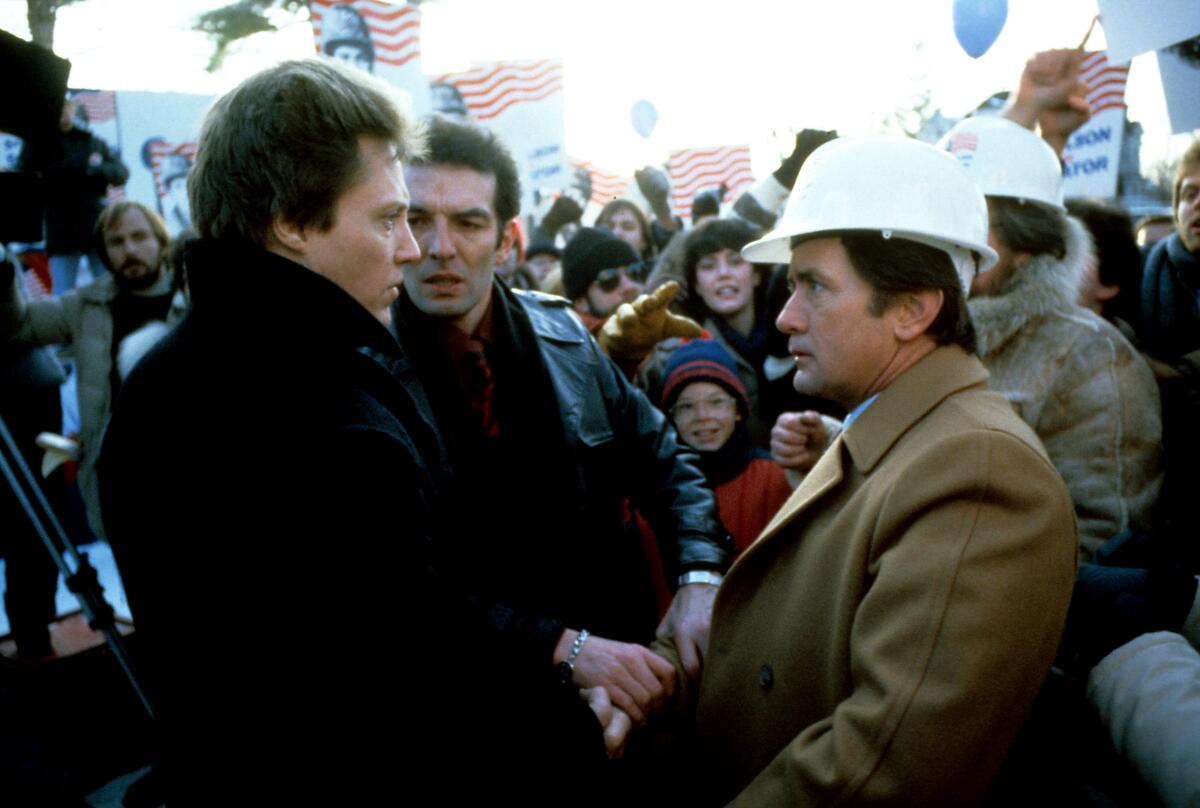The original slasher ‘Black Christmas,’ plus the best movies in L.A. this week

- Share via
Hello! I am not Mark Olsen, who’s on a well-earned break after going mano a mano with Michael Mann, “Heat”-diner-style. I’m film editor Joshua Rothkopf. Welcome to another edition of your regular field guide to a world of Only Good Movies.
If you love and cherish weirdness, if you support the spirit of adventurous voices, today is a holiday: A new movie by Yorgos Lanthimos is finally in theaters. Starring an especially fearless Emma Stone on a journey of sexual awakening through a steampunk Europe, “Poor Things” is one of the Greek director’s wildest films — which is saying something after “Dogtooth” and “The Lobster.” Leave your inhibitions behind and go.

In the view of our critic Justin Chang, Stone’s Bella is the movie. He writes, “It’s not just that Stone’s droll, playful, ferocious and febrile performance dominates almost every scene, or that the severity of Bella’s countenance, with her piercing blue eyes, pale complexion and dark, Rapunzel-length hair, stays with you for days afterward. It’s more that the movie around Bella, brilliantly adapted by Tony McNamara from Alasdair Gray’s 1992 novel, feels like such a singular and unfiltered expression of her consciousness. Lanthimos may have cobbled together a rambunctious psychosexual odyssey from many Frankensteinian parts — a little “Alice in Wonderland,” a dash of “Metropolis,” a soupçon of Voltaire by way of the Marquis de Sade — but he and his skilled collaborators have marshaled them into a remarkably coherent and purposeful vision.”
Our reporter Josh Rottenberg spoke with Lanthimos and Stone, who calls Bella her favorite character she’s ever played. The “La La Land” Oscar winner had this to say about her creative partnership with Lanthimos: “We just get along. We’re able to make fun of each other and share perspectives that might be different. It’s extremely helpful to have that level of comfort, especially when you’re working with subject matter like what’s in this movie. You need to have that kind of trust to be able to let go and know that the captain of the ship is there to really guide things.”
Season’s bleedings

There’s a time and a place for Christmas movies, especially if you prefer your holiday cheer in short, controlled bursts. That time is now. You can’t improve upon the New Beverly’s 35mm double bill playing on Mon. 11 and Tues. 12. First up is the original 1974 “Black Christmas,” starring Olivia Hussey, Margot Kidder and Andrea Martin as sorority sisters stuck at their house over the holidays and plagued by a stalker. (It’s my kind of “Holdovers.”) So ahead of its time as to be stupefying, “Black Christmas” anticipates “Halloween” — and slashers in general — by years. Here you’ll find early versions of “the phone call is coming from inside the house!” and that wobbly POV shot from the killer’s perspective. (There’s a gorgeous 4K home-video transfer of the movie available from Scream Factory.) Stick around for 1984’s “Silent Night, Deadly Night,” not nearly as influential but just as fun with the right crowd, which this will be.
‘Shane’ at the Academy

Maybe it’s hard to think of any Western from the 1950s as being groundbreaking, but “Shane” was a radical, disquieting thing when it came out. Its director, George Stevens, came back from his service in World War II a changed man after capturing footage at the Dachau concentration camp. (His change of heart is beautifully evoked in Mark Harris’ essential film history “Five Came Back.”) “Shane” has, as its title hero, a mystery man who descends into a valley to take out evildoers — he is an angel of death, very much an influence on Sergio Leone and Clint Eastwood. And when the guns go off, they’re frighteningly loud and the bodies fly backward. No film had ever done that before.
For this special 4K screening on Sun 10 at the Academy’s enormous 966-seat David Geffen Theater (one of our favorites in the city), no less a cinema authority than Christopher Nolan will be on hand to discuss the movie’s impact. He’ll be joined by the director’s son, George Stevens Jr.
If you leave the theater yelling, “Come back, Shane!” you won’t be alone. And if you secretly wipe back a tear, you won’t be the only person to do that, either.
David Cronenberg’s finest hour

Sure, Cronenberg’s got many of them, loaded with squishy ickiness. But if we had to pick what is, pound for pound, the director’s most ominous, darkly entertaining movie, “The Dead Zone” would be hard to beat. Derived from the Stephen King novel about a man cursed with the ability to see the future with every handshake (and featuring Christopher Walken at his icy peak), the thriller contains scenes that are so explosive — huge props to orchestral scorer Michael Kamen — you won’t believe they got made.
Today, though, “The Dead Zone” is most notable for its political subplot: the rise of a homegrown American fascist who seems headed toward election as the next U.S. president. A few years ago, I had the opportunity to chat with Martin Sheen about his spooky performance as Greg Stillson and he told me, laughing, “You don’t know how often that one comes up.” Sheen, always politically outspoken, minced no words about a certain “wretched despot.” If you feel you can take it, “The Dead Zone” awaits you on Monday at the Los Feliz 3.
You are reading Indie Focus newsletter
Sign up to get Mark Olsen's guide to movies and what’s going on in the wild world of cinema in your inbox every Friday
You may occasionally receive promotional content from the Los Angeles Times.
Only good movies
Get the Indie Focus newsletter, Mark Olsen's weekly guide to the world of cinema.
You may occasionally receive promotional content from the Los Angeles Times.




